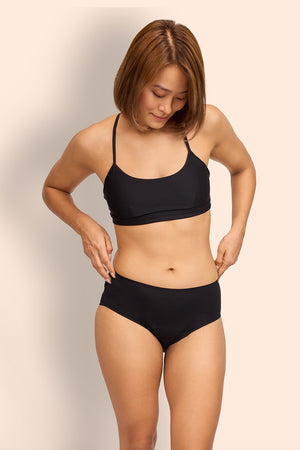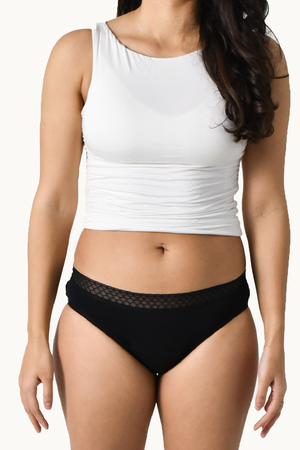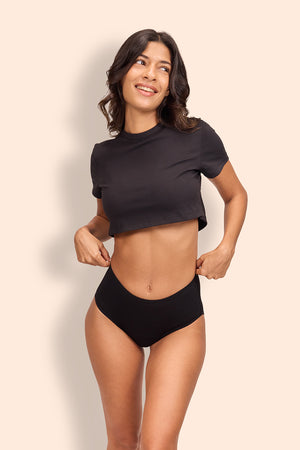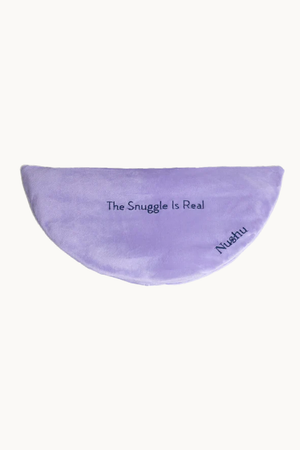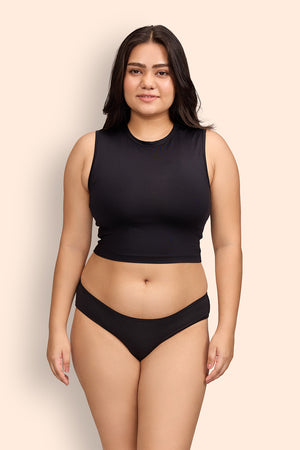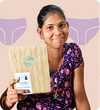Community Spotlight: Living with Endometriosis
Endometriosis affects roughly 42 million women in India alone - that’s 1 in every 8 girls! Globally, that number is roughly ❗247 Million women.❗ For many, the journey to diagnosis is marked by years of pain and uncertainty (read this for a breakdown of what Endo is & it’s symptoms)💔. In this Community Spotlight, Radiyah, a mom & Nushu customer, opens up about her experiences with endometriosis, from early symptoms to daily challenges! 💬In conversation: Radiyah, 39, Mumbai. 👉🏼1. How did you discover you suffered from Endometriosis? Radiyah: I got married in 2009 & at the time, my periods were excruciating! I experienced heavy bleeding as well. No matter how “heavy absorbency” the pads were, I’d have to change every 2-3 hours without fail. At any given point, I’d also carry about 2-3 pads in my bag. Eventually when I started using cups, that’s when I realised how many clots my flow had. Over the years the cramps kept getting worse! It wasn’t until 2013 when a few fainting spells happened, that I got myself checked! 👉🏼2. How did you go about treatment? Radiyah: So the tests revealed a cyst on one of my ovaries, which had to be surgically removed. Since we’d struggled with conception until then, we were informed by the doctors that child-birth often also mitigates the chances of recurrences. Post surgery we conceived soon after! However, due to certain complications, the pregnancy had to be surgically terminated. Against the odds, I finally gave birth to my son a year later :) 👉🏼3. Did the endometriosis ever reoccur post childbirth? Radiyah: Unfortunately, I was one of the minority women who experienced a recurrence of Endo despite childbirth! Over time, the same symptoms started resurfacing & I was diagnosed with Endo for the second time! Surgery followed suit too. This cycle continued for a few years. Each time, the symptoms kept getting worse too! The last time it happened, my doctor told me that my cyst had progressed to becoming an ‘adenoma’, on the exterior part of my uterus. So this time around they suggested an experimental treatment that involved a ‘Mirena coil’ - a coil that releases targeted medication to dissolve the adenoma, as opposed to getting a hysterectomy at the age of 37. 👉🏼4. How have your symptoms/ body changed since then? Radiyah: I’ve been on the coil for about 2 years now, so the pain has significantly reduced. The catch is that instead of a monthly flow, I experience a regular “discharge” of blood which is part of the process. That’s how I discovered Nushu – I needed an alternative to cups since they create suction in the cervix which can potentially tamper with the coil. 👉🏼5. What has your experience been like with Nushu’s period panties? Radiyah: They’re super comfortable! I would often get rashes with pads, even with the organic ones. With Nushu, I’ve never experienced any rashes or discomfort. With pads, I also ended up disposing several in a day – so I was conscious of the waste I generated. Period underwear is definitely more eco-friendly, so I’m doing my bit by making a sustainable choice too! (Find her styles – the Hip Hugger & Bikini Brief right here). 👉🏼6. How has having endometriosis shaped your understanding of your body and menstrual cycle? Radiyah: I’ve learnt how tremendously impactful your body’s hormones are! The slightest change & you see it on your skin, digestion, your sleep & energy – they dictate your body’s natural rhythm. It’s because I was so in-sync with my body, that I was able to identify when something was wrong. 👉🏼7. How has endometriosis affected your daily activities, work, or social life during menstruation? Radiyah: For me personally, it disrupted my routine entirely. When I was on my period, I was practically bedridden & would have to cancel my plans for the day or create plans around period. My immunity was also compromised – if I had a particularly strenuous day, I would fall sick the next day! From a very young age, my son has been aware of what menstruation is, why it occurs, what I suffer from, because he would witness what I had to go through every month. He would just know that for a few days, mom is not going to be as energetic or present as she normally is. That’s also made him extremely sensitive and mature for his age. 👉🏼8. What practices have been most helpful in managing symptoms? Radiyah: I’ve never had any dietary restrictions, although I think mindset has greatly affected how I look at it – I know women go through more dire & unfortunate circumstances, so it gives me strength to push through! 👉🏼9. What advice would you give to someone newly diagnosed with endometriosis about navigating life with this condition? Radiyah: Endometriosis might look different for every person, but it's crucial for everyone to be super aware of the health risks they’re exposed to! You need to be able to read your body & detect when something is off. That’s the only way you can catch something in its early stages. — Radiyah’s journey is a testament to the strength & resilience it takes to navigate life with endometriosis💪🏻. Her story reminds us of the importance of❗listening to our bodies and seeking help❗when something feels off—no matter how small it seems. If you’re experiencing persistent pain or unusual symptoms (we have a few listed here), don’t hesitate to consult a healthcare professional. Early diagnosis and support can make all the difference in reclaiming your health and well-being.
Learn moreTraditional Wisdom and Menstrual Wellness
Makar Sankranti/ Baisakhi/Vasant Panchmi – call it what you will, it is that perfect time of the year when winter’s chill starts to ease, and the season’s warmth & treats are everywhere!There’s more to these festivals than bonfires & sesame treats. The foods we eat during Sankranti, like til-gur laddoos and khichdi, are steeped in traditional wisdom that goes beyond taste—they nurture our bodies, including menstrual health! 1. Til-Gur: A Winter Superfood for Hormonal Harmony 🌞 Sesame seeds (til) and jaggery (gur) are the season’s culinary stars, and for good reason. They are rich in calcium, magnesium, and zinc—all crucial for supporting hormonal balance and easing PMS symptoms. Jaggery, on the other hand, is a natural sweetener packed with iron, which helps combat anemia—a common concern during menstruation. Plus, its magnesium content can help soothe cramps. Together, they’re like a tag team for menstrual wellness, ensuring your body gets both energy and vital nutrients! ✨ Cycle Tip: Snack on til-gur laddoos during your luteal phase (PMS week) to curb cravings and boost your mood. 2. Khichdi: The Ultimate Comfort Food for Your Gut 🍚 Khichdi, a humble mix of rice, lentils, and spices, is a staple that’s as easy on your tummy as it is on your taste buds. Its light, nutrient-dense profile supports digestion, which can often take a hit when it's cold & also closer to your period. The turmeric in khichdi reduces inflammation as well — great for soothing those dreaded cramps. ✨ Cycle Tip: Cook khichdi during your period for a gentle, warm meal that feels like a hug for your insides. 3. Ghee: The Unsung Hero of Menstrual Health 🧈 No harvest-season dish is complete without a drizzle of ghee. This golden elixir isn’t just delicious—it’s packed with healthy fats that support hormone production and keep your energy levels steady. Ghee is also known for its grounding properties in Ayurveda, helping to calm the mind and reduce stress. If your period leaves you feeling frazzled or fatigued, ghee might just be your best friend. ✨ Cycle Tip: Add a spoonful of ghee to your khichdi or laddoos for an extra boost of nourishment. 4. Chikki and Revdi: Sweet Treats with a Purpose 🍬 Chikki (a brittle made with peanuts and jaggery) and sesame revdi are classic sweets that double as nutrient powerhouses. Peanuts are high in protein and magnesium, supporting muscle relaxation and reducing bloating, while jaggery keeps your energy levels stable. These snacks are proof that indulgence & health can go hand-in-hand! ✨ Cycle Tip: Enjoy chikki during your follicular phase (the week after your period) for a burst of energy to kickstart your month. Traditional Wisdom Meets Modern Wellness The harvest-season foods aren’t just festive treats—they’re ancient solutions to modern health concerns, including menstrual wellness. By eating seasonally & embracing nutrient-rich dishes, you’re nourishing your body in harmony with nature and tradition. So, as you savor that til-gur laddoo or warm bowl of khichdi this Sankranti, remember: you’re not just celebrating a festival—you’re honoring your body’s needs. 🌟
Learn moreFrom Hot Mess to Hot Yoga: Why Exercise Is Your Period’s BFF
Let’s face it: irregular periods feel like that one flaky friend who cancels plans last minute — every single time. 🤦🏻♀️The good news? Exercise might be the ✨magical✨ calendar invite that gets your cycle back on track. Here's why working out works, and once we break down the science, we’ve made notes on easy, winter-friendly ways to sweat without freezing your buns off ! How Exercise Brings Aunt Flo Back on Schedule 🏋🏻♀️ 1. Balances Hormones Your hormones are like that drama-filled group chat—one message out of place, and everything spirals. 🫠Exercise helps balance insulin (which controls blood sugar) and cortisol (the stress hormone). When these two are out of whack, they can throw off your reproductive hormones like estrogen and progesterone, making your period unpredictable. Regular workouts hit mute on the unnecessary chaos, helping your hormones sync up. 2. Reduces Stress (Bye-Bye, Hormonal Chaos) Stress is your period’s arch-nemesis. When you’re stressed, your body produces more cortisol, which can disrupt the signals between your brain and ovaries.Exercise not only lowers cortisol levels but also releases endorphins, your body’s ✨feel-good chemicals.✨ It’s like a natural mood booster that helps your period find its way home. 3. Improves Blood Flow (Because Your Uterus Deserves Love Too) Exercise keeps your circulation🩸 game strong, ensuring that all the key players—your uterus, ovaries, and the whole gang—get the blood flow they need. Better blood flow means fewer cramps and a smoother menstrual cycle overall. Think of it as sending your reproductive system a care package filled with everything it needs to function like clockwork!4. Boosts Ovulation (The OG of Period Health)If you’re not ovulating regularly, your periods can go AWOL. Exercise, especially moderate-intensity workouts, can help regulate ovulation by keeping your hormones in sync. When ovulation is on point, your cycle follows suit like a well-rehearsed routine.In short, exercise isn’t just about sweating it out—it’s about becoming your body’s ultimate ✨hype woman,✨ cheering it on to function at its best! 👯 Winter-Friendly Workouts That Don't Make You Want To Hibernate With winter knocking at our doors (and us knocking back hot chocolate like it's a sport), finding ways to keep moving is key.🔑 The trick is finding ones you’ll actually enjoy! Depending on where you are in your cycle, try a combination of these low-high intensity workouts, through the month. 1. Yoga: Hot Studio or Home Style 🧘♀️ Yoga is the MVP of winter workouts – especially when you’re menstruating. Focus on getting in ample stretches that help your muscles relax. Our go-to styles for a period workout – The Hip Hugger & Lace Bikini – both have padding all the way to the back, to avoid leaky-disturbances in your workout! 🩸Not only does yoga keep you warm & stretchy, but it also boosts blood flow to the pelvic region, which is a big win for period regularity. Bonus: You can do it in fuzzy socks! 2. Walking… But Make It Cozy 🚶♀️Bundle up, pop in your favorite podcast or your fave hype-me-up playlist (try out our fave), and take a brisk walk. The crisp air can actually feel refreshing (as long as you’re not dressed like you’re headed to Antarctica). 3. Indoor Dance Cardio 💃 Turn your living room into a disco with dance cardio workouts🕺🏻A cheeky YouTube playlist can get you grooving before you know it! Plus, it’s hard to feel cold when you’re busting moves like nobody’s watching. 🤷🏻♀️4. Strength Training at Home 🏋️♀️No gym? No problem. Grab some resistance bands or use your own body weight to slay some squats, push-ups, and planks. It’s like having your very own winter boot camp—minus the frosty air. ❄️ Pro Tips to Stay Motivated! - Layer up smart: Sweat-wicking fabrics are your winter BFF. - Buddy up: Misery loves company, but workouts with a friend make it way less miserable. - Set mini-goals: Even 15 minutes counts. Think small, win big. The Bottom Line Exercise isn’t just about looking good; it’s about feeling good—and that includes your periods. Plus, with these winter-friendly ideas, you can crush your workouts without turning into an icicle. So grab your yoga mat, lace up those sneakers, and show winter who’s boss. Your body (and your cycle) will thank you. 💪🩸
Learn moreHow Winter Messes with Your Period (Yep, It’s a Thing)
If you’ve noticed your period acting all weird in winter, let us tell you – you’re not imagining things. Turns out, your menstrual cycle isn’t immune to the cold. From worse cramps to irregular cycles, winter does some sneaky stuff to your body! So, grab your heating pad, and let’s dive into the why & how of winters wrecking your🩸vibe. ❄️Winter = fewer daylight hours = less vitamin D The "sunshine vitamin" keeps your bones happy and your hormones balanced. 🌻 When your vitamin D dips, your reproductive hormones (like estrogen and progesterone) can start acting up, making your period irregular or longer. So, if your period’s gone MIA or is playing hide and seek, the winter sun—or lack of it—might be to blame. 🥺 Then there’s melatonin—the sleepy-time hormone your body makes when it’s dark. Winter’s long nights mean more melatonin, which is great for napping😴 but not so great for keeping your period on track. Too much melatonin can interfere with ovulation. So, if your cycle’s all over the place, thanks, winter. 😪 ❄️Cramps Are Worse? Of Course They Are If your cramps feel like they’ve cranked it up a notch during winter, you’re not imagining things. Cold weather can shrink your blood vessels (yep, even the ones down there), reducing blood flow to your uterus and making cramps feel more intense.🫠 Basically, it’s like a cramp apocalypse. Science backs it up, too—a study in Menstrual Disorders found that women reported worse cramps during colder months. 😓 The good news? Exercise can help. I know, it’s freezing, but even light activity increases blood flow and releases endorphins—your body’s natural painkillers. 🌸 If the fear of leaks are getting in the way, we gotchu covered – Lace Bikini & the Hip Hugger are customer favourites for workouts, since their padding goes all the way back! So, maybe consider a quick stretch instead of curling up under a blanket for 12 hours straight. Maybe. ❄️SAD Times, Literally Winter doesn’t just mess with your body; it messes with your brain, too. Enter Seasonal Affective Disorder (SAD), that fun little bout of winter-induced melancholy. 😩 Stress from this increases your cortisol levels, which can throw off your hormones and lead to irregular periods. We’ve all experienced this first hand too – when we’ve had a stressful month, our cycle tends to skip a beat! Plus, more painful PMS. 🩸 ❄️Comfort Food? Not as comforting to cramps Winter has a way of making you crave all the comfort foods— hot mac and cheese, anyone? Here’s the catch though: Diets high in salt & sugar can make your period worse. 🍕Salt = Extra bloating 🍩Sugar = Blood sugar crashes So swapping out a gooey brownie for a few bites of dark chocolate can help ease cramps. Still a win, right? ❄️How to Survive the Winter Period Chaos So, what can you do to survive winter’s assault on your period? Here’s the quick survival guide: 1. Get some sun: If you can’t, consider a vitamin D supplement. Your hormones will thank you. 2. Stay active: Even a little bit of exercise can help reduce cramps and keep your hormones balanced. 3. Eat smarter: Swap the salty, sugary snacks for foods rich in magnesium. (Yes, chocolate counts.) 4. Stay warm: Heating pads, hot baths, cozy blankets—whatever keeps you warm will help those cramps chill out. Winter might throw your menstrual cycle off its game, but with a few smart moves, you can keep it from totally ruining your vibe. 💃🏽 And hey, just remember—spring is right around the corner!🌸
Learn moreEstrogen: The grand-mistress of your body!
Estrogen is the spotlight hormone when it comes to women’s health, and for good reason!! Most women think estrogen only controls their menstrual cycle, but the truth is - It affects women's health from A-Z!! We’ve summarized all that estrogen offers: ⏱️ Keeping Your Menstrual Cycle on Track One of estrogen’s most well-known roles is to regulate your menstrual cycle. This hormone helps prepare your uterus for a possible pregnancy by thickening the uterine lining with blood & mucus. 🩸 During the first half of your cycle, estrogen levels rise (mood elevates) ⬆️ triggering ovulation. If pregnancy doesn’t happen, estrogen levels drop (hello PMS) ⬇️ and you get your period! 🌼 Reproductive health Estrogen plays a key role in teenage development - hello boobs 👙. In adulthood, it keeps your vaginal tissues 🍉healthy and lubricated!🍉Nobody likes an itch they can’t itch, right? 🪄The Ultimate Skin Care Product Ever noticed how your skin is at its ✨glowing best✨ when you’re nearing ovulation (check out our blog post on cycle phases)?It’s all thanks to the big E, which maintains skin elasticity and hydration, giving collagen production a natural boost! 🚀When estrogen levels drop⬇️, collagen production drops⬇️, and your skin can become drier and prone to wrinkles. 🥰Influencing Mood and Mental Health Any woman who bleeds knows – mood swings be swinging(!!!) around your period or during menopause! Estrogen affects brain chemicals like serotonin that regulate your mood. Fluctuations in estrogen can lead to mood swings and the onset of PMS 😓 Conversely, your serotonin levels are getting the natural boost they need nearing ovulation, because this is when estrogen peaks, making you happier, calmer & more outgoing! 🥳Check out our article on menstrual moods for more information on hormones & moods. 💪🏼Affecting Metabolism and Weight Estrogen impacts how your body processes carbohydrates and fats. It also influences where your body stores fat, usually around the hips and thighs. Changes in estrogen levels can affect your weight and body composition. Consuming foods that naturally boost estrogen, can support overall weight management goals. The bottom line: Estrogen is more than just a hormone; it’s a vital part of your health and wellbeing! From regulating your menstrual cycle to keeping your metabolism under check, this hormone touches so many aspects of your life!! 🍎Understanding how estrogen works can help you make informed choices about your health, whether you’re navigating puberty, pregnancy, or menopause 🌼 Sourceshttps://www.hopkinsmedicine.org/health/conditions-and-diseases/estrogens-effects-on-the-female-bodyhttps://www.ncbi.nlm.nih.gov/books/NBK538260/https://www.medicalnewstoday.com/articles/277177
Learn moreThe Secret Life of Female Libido: Transitions Across Every Decade
It’s totally natural for your sex drive to ebb and flow over time! 🌊 As life rolls on, your libido can hit new highs or take a dip, thanks to causes like shifting hormones, a job switch, or a new relationship! Don’t expect a dramatic shift when you hit a new decade—libido changes tend to sneak up as you move from your 20s to your 40s and beyond. 🌻 🌪️What causes your sex drive to change? It seems like a straightforward question, but what makes a sex drive… drive(?) is still a mystery, even to scientists!! 😕 Hormones, yes, but other factors—psychological, social, and physical—also contribute to transforming your libido.✨Your 20s✨Your body is the most fertile from ages 25-30, which explains why your dating app swipe-range is ‘wide’💃🏽 Some scientists also believe that female desire increases as peak fertility wanes – so when you’re 29, going on 30! 👀✨30s and Early 40s✨Hitting 30 doesn’t mean your libido takes a plunge, but when your craving for physical intimacy starts to dip, blame it on your testosterone taking a little vacation! 🫠 Stress is a real buzzkill too, messing with your hormones by lowering testosterone and cranking up cortisol! 📈Plus, with life getting busier and responsibilities piling up, your sex drive might not be a priority. Kids!!!!!! 👶🏻No matter your age, pregnancy and childbirth can shake up your sex life in all sorts of ways.During pregnancy, hormonal and body changes could dial up your libido—especially in the second trimester—while at other times, it could take a dip. 🤰🏻Worries regarding the safety of sex during pregnancy, could bring hesitation. Post-childbirth, juggling childcare and the million other things on your plate impacts your time, energy, and interest in sex.✨50s and Beyond✨As you hit the “Golden Jubilee” mark, you might find yourself with an empty nest & fewer responsibilities, which could spark a renewed interest in sex. However, the closer you get to menopause, lower estrogen levels taper your libido! Throw in other menopause symptoms like hot flashes, anxiety, weight gain, and sleep trouble – sexy-time becomes the least of your worries. If you find yourself in this position, go easy on yourself, and allow your body to go through its natural phases. 💜 But there’s one thing to help, no matter what your age… ❗Keep the lines of communication open with your partner❗Talk about your needs, desires, and what feels good as your bodies change and life evolves. Trying new things can keep the spark alive, and honest conversations about what works for you both are key. Setting aside some special time for intimacy can also do wonders! Sources:https://www.webmd.com/sex-relationships/ss/slideshow-sex-drive-changes-agehttps://www.mayoclinic.org/diseases-conditions/low-sex-drive-in-women/symptoms-causes/sychttps://www.ncbi.nlm.nih.gov/pmc/articles/PMC4720522/https://www.researchgate.net/publication/325437603_Average_Associations_Between_Sexual_Desire_Testosterone_and_Stress_in_Women_and_Men_Over_Time
Learn moreYour birth control options (and exciting innovations!!!)
Contraceptives are a game-changer when it comes to taking charge of your reproductive health.💗We’re breaking down the pros and cons of some popular contraceptives you’ve probably heard about, plus a sneak peek at some cool new innovations on the horizon (finally!) 🥳But first things first—make sure you ❗chat with your gyno❗ before picking any of these, because, well, they know best! The Usual Suspects (other than male condoms) 💊Birth Control Pills These pills are the most popular contraceptives out there. Packed with hormones (either a mix of estrogen and progestin or just progestin)💉they work to prevent ovulation by altering your hormonal cycle (not exactly the healthiest option). The pill requires a prescription and good memory — they have to be taken at the same time every day.⌚➕Pros:- Effective when used correctly—around 91% success rate!- Helps regulate periods and ease cramps.- Can improve skin—hello, fewer breakouts!- Easy to get from a local pharmacy (granted you have a prescription).➖Cons:- Daily commitment—don’t forget!- Unnaturally manipulates your hormonal cycle- Potential side effects like nausea, weight gain, and mood swings. 👀 Intrauterine Devices (IUDs) IUDs are tiny, T-shaped devices that get placed in your uterus by a doctor. There are two main types to choose from: hormonal and copper. The hormonal ones release progestin to prevent fertilization, while copper IUDs create a hostile environment for sperm! ➕Pros:- Long-term protection—3 to 10 years, depending on the type.- Less than a 1% fail rate.- Low maintenance once it’s in place.➖Cons:- Might cause spotting or irregular bleeding at first - Copper IUDs can make your periods more intense.- Insertion can be uncomfortable.- There’s a rare chance it could fall out or move. 🩹 Contraceptive Patches The patch is like a sticker you slap on your skin—usually on your tummy, butt, or upper body! It releases hormones 💊 to prevent ovulation and needs a swap every week for three weeks, with one patch-free week during your period 🩸➕Pros:- Super easy to use—just change it once a week.- Regulates your cycle, just like the pill.➖Cons:- Might irritate your skin.- Alters your hormonal cycle.- Similar side effects to the pill.- Not easily available—mostly in hospital pharmacies. 🚺Female Condoms These are thin plastic pouches that line the vagina, giving you protection during sex. You can pop one in up-to 8 hours before the fun begins by guiding it into place with a flexible ring.⭕➕Pros:- Widely available – online too!- Offers protection against some STDs- Don't mess with your hormones!!!➖Cons:- Roughly a 21% fail rate.- Not reusable! What’s Next? While these options aren’t very enticing, there’s a silver lining! The world of 💥fem-tech is booming💥 & investments are finally flowing in!! The industry is expected to hit a whopping market value of $5 billion by 2033, growing at a solid 15.2% annually (according to a press release from Future Market Insights Inc). Here are some exciting innovations to look out for! 🤌🏽✨ 1. Vaginal Gel This one’s a cool development that’s already available across the US & UK. It’s non-hormonal too!! It works by keeping the vagina’s pH low, making it tough for sperm to survive (code for spermicide) ☠️ It comes in prefilled applicators and can be used up to an hour before sex—pretty neat, right? 🤯 2. Biodegradable Implants Biodegradable implants are small, flexible rods that release hormones like progestin (similar to the patches) to alter your hormonal & ovulation cycle. They eventually break down naturally in the body — no removal needed! 😮They’re still a WIP, so they’re not readily available in any markets just yet! 3. Male Birth Control Pills Yup, they’re finally working on a pill for the guys!!! Combining testosterone and progestin, these pills aim to suppress sperm production, offering a reversible option. 🤌 The side effects are similar to those of female birth control pills.They’re still undergoing clinical trials in the US & UK, so no luck on any approved pills yet 🤷🏻♀️ 😌Wrapping It Up Choosing the right contraceptive is a personal decision that depends on your health, lifestyle, and what you feel most comfortable opting for. With so many options available—and even more exciting ones on the way—women have more control over their reproductive health than ever before! 🎈🥳Just remember to always consult with your gyno to find what works best for you!
Learn moreBreaking down Endometriosis
Endo is known for that excruciating pain condition that sometimes takes years to diagnose. Nearly 42 million women suffer from Endometriosis in India alone - that’s 1 in every 8 girls! Globally, that number is roughly 247 Million women. Yet, the causes (and permanent solutions) are still a global enigma to the general population as well as the medical community by far! What is Endometriosis? Endometriosis is a painful condition where endometrial-like tissue grows outside the uterus, often on the ovaries, bowel, and pelvic lining. This tissue responds to hormonal changes during the menstrual cycle, becoming inflamed and causing pain. The trapped tissue can lead to irritation, scar formation, adhesions (where tissues bind together), severe menstrual pain, and fertility problems. ⚠️What are the symptoms: Women often experience either some or all of these symptoms in varying degrees: -Pelvic pain: The most common symptom! - Painful periods and cramps: Occurs for 1-2 weeks around menstruation - Heavy menstrual bleeding: Can include bleeding between periods - Infertility: A significant complication for many - Pain during intercourse: Often experienced by those with the condition - Bowel discomfort: Painful bowel movements - Lower back pain: Can occur at any point during the menstrual cycle Regular gynaecological exams are crucial for monitoring symptoms and changes. 💭What causes Endometriosis? While the exact cause of this condition is unknown, the medical community has a few theories: Retrograde menstruation: Menstrual blood flows backward through the fallopian tubes into the pelvic cavity, which apparently several women experience! This is the oldest theory that exists 👀 Cell transformation: Parts of your abdomen tissues convert into endometrial-like tissue and act like endometrial cells too! They may even grow, thicken, and bleed over the course of your menstrual cycle in response to the hormones of your cycle. The reason? Unknown. (Welcome to the frustration of under researched women’s health 😩) Foetal Conditions: The Mullerian theory suggests that endometriosis might start in the foetal period with misplaced cell tissue that begins to respond to the hormones of puberty. Genetics and environmental toxins might also play roles in its development!! Some factors might make it riskier… 👉🏼Age: Women in their 30s and 40s are more susceptible than someone in their 20s! 👉🏼Family history: If a family member has experienced the condition before, you might be at a higher risk 👉🏼Pregnancy history: Although Endometriosis can still occur in women who’ve had children, women who have not, are at an increased risk (we get the frustration, really!) 👉🏼Menstrual history: Issues like shorter cycles, heavier and longer periods, or early onset of menstruation can increase risk 🩺How is it treated? It's natural to seek prompt relief from the pain and other symptoms of endometriosis; untreated endometriosis can significantly disrupt daily life. Although there is no cure for endometriosis, its symptoms can be managed 🌼 Initially, your doctor may suggest conservative treatments, moving to surgical options if there is no improvement. Using supplemental hormones prescribed by your gynac can sometimes help alleviate pain and halt the progression of endometriosis too! 💊 Laparoscopy, a minimally invasive surgery, is also used to both visualise and diagnose endometriosis. It is also used to remove displaced endometrial-like tissue. Lasers are a pretty commonly used non-invasive method to destroy this “out of place” tissue as well. Conclusion Endometriosis can be a painful, exhausting condition to live with, which not only deserves compassion, but also immediate medical attention! The sooner it's diagnosed, the better. If you suspect you have endometriosis (or even if something just feels off), it is ❗ suuuper important to visit your gynac immediately❗ Regular visits to the gynac can help detect medical conditions at a much earlier stage, when they can be treated with more ease 🌸 Sources: https://www.ncbi.nlm.nih.gov/pmc/articles/PMC7615030/ https://www.hopkinsmedicine.org/health/conditions-and-diseases/endometriosis https://www.ncbi.nlm.nih.gov/pmc/articles/PMC3935015/ https://www.healthline.com/health/gynecologic-laparoscopy https://www.healthline.com/health/endometriosis#treatment
Learn moreWe need to talk: Is pain during sex really normal??
Pain during sex is much more common than you think – up to 75% of women experience it at some point. While some women may only experience occasional pain, others may deal with persistent discomfort. It's possible to experience pain and discomfort, even if you previously have not. 🙁 This mightttt just want you to avoid sex sometimes, but that’s not a solution, is it? That’s when you know it’s time to visit the gynac! 👩🏻⚕️ 😷 Addressing the Stigma Sexual health often carries a stigma that needs to be tackled. Recognising painful sex as something to be looked into, is Step #1 of tackling the stigma. Although pain during sex is common, it shouldn't be accepted as normal. Occasional minor soreness is usually not a concern, but persistent or intense pain warrants a conversation with your doctor. Sex should be pleasurable, girls! If it's not enjoyable anymore, discussing discomfort with your partner and doctor is important. Prioritise your sexual health, just as you would your physical or mental health! Common cause: Dryness Dryness is a frequent cause of painful sex, affecting women of all ages, though more common in perimenopausal and postmenopausal women. Dryness can also lead to infections, exacerbating the pain. 😖 The use of birth control, breastfeeding, and menopause are some of the most common causes of dryness down there! Solution? Easy – using a water-based lubricant can help significantly! 💦 Ensure that you and your partner engage in ample foreplay to get your body’s natural lubes working for you too ;) ❗Seeking Help ❗ Painful sex usually has an identifiable and treatable cause. If you're avoiding sex due to pain, it's time to see a doctor, with a gynaecologist being a good starting point for diagnosis. Many women are hesitant to discuss pelvic issues, but it's important to open up to friends, loved ones, and healthcare providers! 👩🏻⚕️ Women often blame themselves for sexual dysfunction, which can lead to delayed diagnoses in many cases. Recognizing it as a health issue, reducing the stigma around discussing sexual health, and seeking medical advice can help find relief and take much-deserved pleasure in sex! 💃🏻 Sources: https://www.cedars-sinai.org/blog/pain-during-sex.html https://www.healthline.com/health/dyspareunia#diagnosis
Learn more












